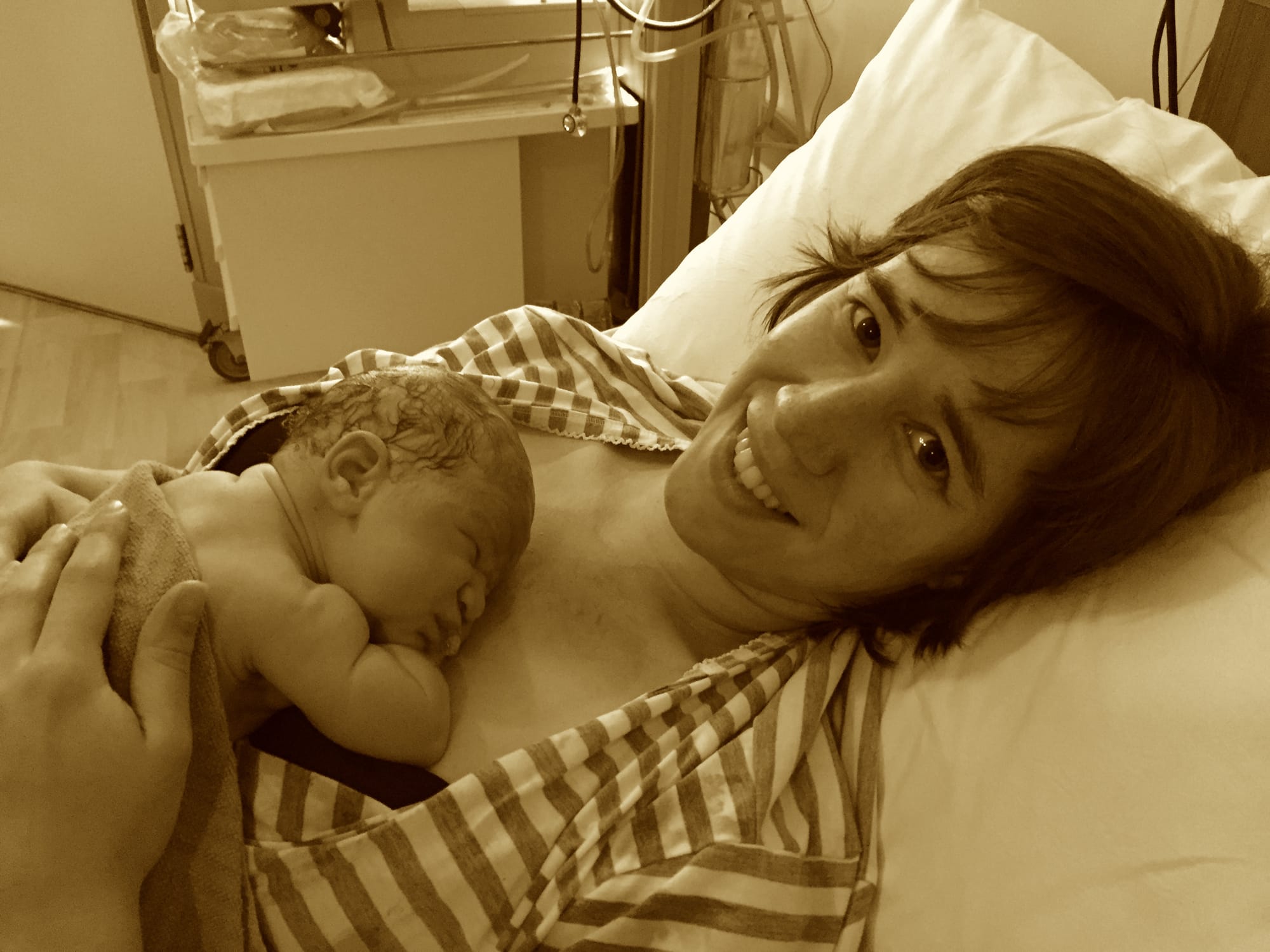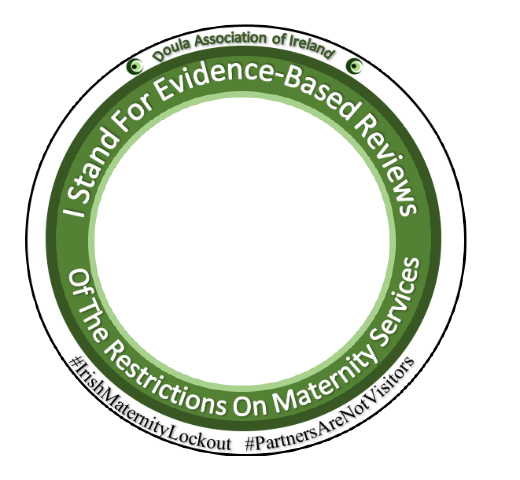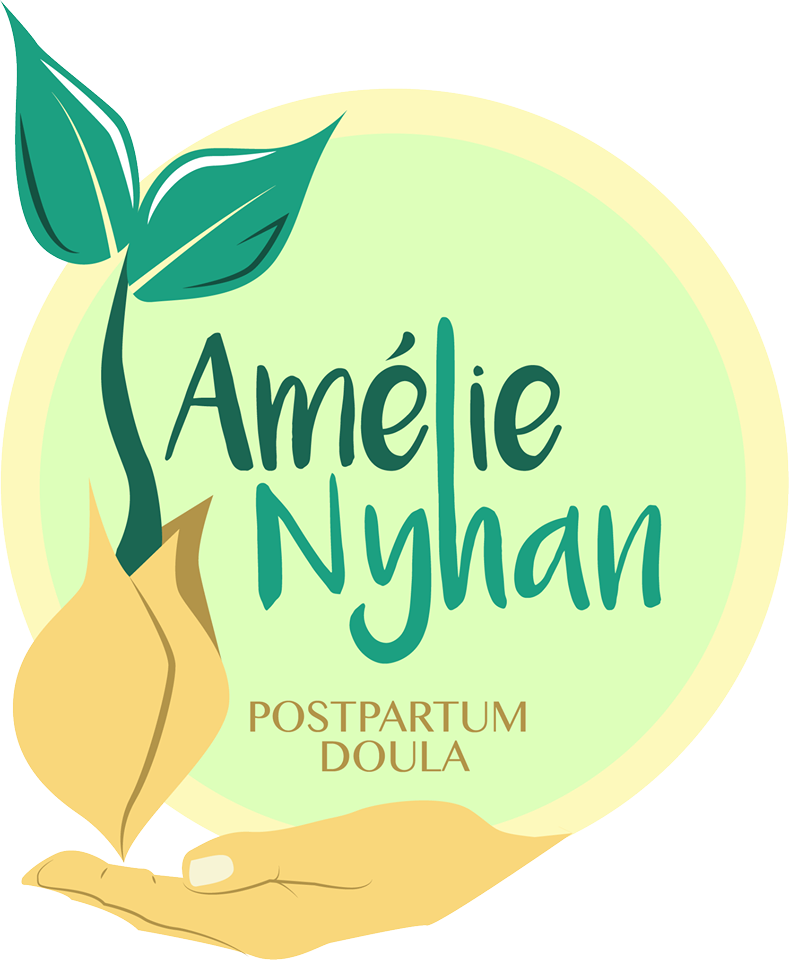The case for Birth Companions: why having a chosen and trusted birth partner continuously during labour matters.
In March 2020, at the very beginning of the Covid-19 pandemic in Ireland, Maternity Hospitals took drastic measures to keep the disease out of their premises and protect mothers, babies and their own staff.
These measures closed the doors to birth partners and consequently forced women to go through labour, no matter how long or short, mostly alone. This left them in the hands of medical personnel, mere strangers to them. Additionally, perinatal non-medical support became difficult to access as Doulas and other professionals were considered non-essential and prevented from practicing.
In the midst of a world-wide pandemic, these restrictive actions were un-questioned and decision-making agencies were trusted and given the green light to whatever policies they felt was right to prevent the spread of the disease.
Six months later, these restrictions have remained in place, unchanged and unchallenged. Slowly, the faint sound of voices is starting to be caught behind the raucous clamours of major lobbies shouting for the economy, against travel bans and for more freedom to be restored.
Soon, these voices will have to be heard.
How childbirth works
There are many different ways labour can manifest itself. It can be a slow and calm process for hours and then pick up rather quickly, it can be a fast paced, no-time-to-think event, it can be anything in between.
For some women, labour will start by itself, in the comfort of her own home and build up gradually until she needs to make a move towards the hospital. She may live close to her Maternity Hospital and have the luxury to feel she will always have time to get there. For others, panic may set in relatively quickly and if the journey to the nearest maternity hospital is rather long, they may feel they need to be in the hands of professionals and not so comfortable staying at home for too long.
Not so rarely, a family will be told that the birth needs to be induced or that an elective caesarean section is needed. In those instances, none of the labour, may it be early stages or active, will happen at home and then, the time spent in hospital before the birth is a complete unknown.
If you are having your second, third or subsequent baby, chances are you and your partner are well seasoned in the process of childbirth. You know your own body’s reactions and pain threshold, and your partner has experience with supporting you. However, each time may be completely different, and you may always be taken by surprise! If you are having your first baby, you are in even more unknown territory. The intensity of your contractions as well as the different feelings and reactions are new to you, and your partner may feel under pressure and unsure how to respond to your needs during this new experience.
In pre-Covid times, you would spend as long or as little time in your own home, labouring peacefully or deciding together, with your partner or birth companion, when is the right time to make your way to the hospital. When you have the certainty that your support system will not be disturbed by a move to the hospital, you may feel more at ease and confident in the process.
The entire experience of childbirth when lived together, as a family unit, contributes to your own family history, provides deep and meaningful shared memories and strengthens your bond as a couple at the very beginning of your shared relationship with the child you are bringing to this world together.
When you are in the process of childbirth, you enter a bubble. A birth bubble is a relatively fragile thing that needs to be protected. When it is, you feel empowered and strong. When you are allowed to remain within this bubble, it can act as a protective shield against stress and anxiety.
This allows for an increase of your oxytocin levels, and lowers you stress hormones.
A little bit of science
Oxytocin is well known as the ‘love and bonding’ hormone. As explained by Kerstin Uvnäs Moberg in her book “The Oxytocin factor”: “oxytocin has the ability to lower blood pressure and pulse rate, reduce the level of stress hormones, increase tolerance of pain, and promote learning and a feeling of calm.” Furthermore, she explains “We feel good when we’re near people we like. […] Physical closeness and touch provide us with a feeling of security, help us relax and calm down.”
On the opposite end of the spectrum, we find stress hormones, also known as the ‘fight or flight’ system. Cortisol and adrenaline levels rise when we feel scared and in need to defend ourselves against enemies. Without the presence of healing and comforting oxytocin, the stress hormones take off. In regards to those stress hormones, Kerstin Uvnäs Moberg says that: “We customarily regard the stress of separation as unhealthy. A separation from someone we are close to, whether it is voluntary or involuntary, has powerful effects.”
To go a little further in understanding the biological process of childbirth and the hormones involved, I would invite you to read the article “Universal Needs of Women in Labour” (Here) it explains quite concisely that:
“When mammals feel threatened, hungry or cold, their bodies release adrenaline. Adrenaline stops the release of oxytocin. During labour, oxytocin is the hormone which makes the uterus contract. If oxytocin levels fall during labour, contractions will slow or halt and the circular muscle fibres of the cervix, tighten. This is a clever survival strategy to allow a mammal in labour to get away from the threat, and labour and give birth somewhere safer.
If adrenaline can stop labour contractions, then a basic need of a labouring mammal is to experience minimal adrenaline release. She will need to be somewhere she feels safe, undisturbed and warm. These are the basic needs of a mammal in labour and women are mammals.”
In his book “Men, Love & Birth”, Mark Harris also talks about birth from an evolutionary and hormonal point of view: “The limbic system is the mammalian part of the brain. When a woman who is giving birth is able to lose herself in the work of this ancient system, which is responsible for the hormones that start and keep the birthing process going, and when the thinking work of the neocortex is turned off, she is simply a mammal birthing, an animal responding instinctively. No meaning-making (talking ,thinking) is required to make the birth of her baby successful.”
Please, look at the words in bold characters above. This is a summary of the science of the childbirth process and the needs of the birthing person in a nutshell.
How birth companions support a positive hormone release
Oxytocin is a powerful hormone which encourages bonding, love, strong contractions and successful birthing. This hormone is released when a person feels safe, loved, cared for and warm, with the presence of a trusted and known person or people around her.
Disturbing the release of oxytocin during labour can lead to the process becoming much longer, more painful and an overall less positive and disempowering experience. In order to promote the calm and connection system during the entire process of childbirth, continuity of care and support is essential and any breach into this system is damaging.
One trusted constant is necessary as the woman goes deep within herself to allow her thinking brain to shut down and her mammalian self to instinctively take over.
In the words of Milli Hill in “ The Positive Birth Book”: “Try to surround yourself with people who understand you and the kind of birth you want, and who can bring a really calm, helpful presence to your birth room.”
This constant takes the form of trusted and known birth companion(s).

How birth companions support human rights in childbirth
Additionally, if or when medical intervention is being considered or is necessary, a trusted birth companion is essential in the decision-making process. Isn’t it inconceivable that a woman who should be focusing inwards and protected within her own birth bubble be asked to make decisions in regards to procedures or interventions that demand a clear mind and an ability to process information, in an instant, all by herself?
We have established above that to protect the hormone systems in place during labour, the birthing person needs to be undisturbed, feel protected and shut down her thinking brain.
A birth partner, as described by Rebecca Schiller in “Why Human Rights in Childbirth matter” is : “a person you choose to have with you during your labour, in addition to any health professionals. Many women choose the baby’s father to be their birth partner, but birth partners can also be same-sex partners, family members, friends or professional birth supporters such as doulas.”
When a birth companion is present during the birth process from the early stages, in a continuous manner, he or she will have been part of the experience from the beginning and will learn and adapt as the process develops. This person will have full visibility as to how the birthing person is doing, coping and reacting to her own labour. In the early stages, they will have been able to communicate effectively, plan ahead and make informed decisions as the situation progresses.
If the birth companion is ‘called in’ in the later stages of labour, as the intensity is at its peak, this person is quite literally being dropped-in near the end of the story that is being told. He/she does not have the premise of what has been going on so far, no insight into the state of mind of the protagonist and no visibility as to how the current plot has been building up. Given this situation, how well can this birth companion now support the birthing person and help her make decisions according to her choices and needs or on her behalf if necessary?
Evidently, if the birth companion is a life partner or relative or a professional Birth Doula, the way communication and advocacy is being practiced will be different.
Article 8 of the European Convention on Human Rights gives protection to every person in regards to their right to make choices within the remit of their private life, this includes choices about birth partners.
In their publication “Respectful Maternity Care Charter: The Universal Rights of Women and Newborns”, The White Ribbon Alliance outline in article 2 that: “Everyone has the right to information, informed consent, and respect for their choices and preferences, including companion of choice during maternity care and refusal of medical procedures.”
When the birthing person is not granted continuous support by a trusted birth companion and offered the benefits of the presence of a support person she knows and trusts, are her basic human rights being upheld? When a parent is not being given the full picture of the situation or is not able to make decisions confidently enough because of the lack of visibility, then are their basic human rights being upheld?
How is informed consent truly practiced when a birthing person has been left in the hands of trained and experienced medical professionals, yet strangers to her, and their birth companion is only being brought in when the process has reached the highest level of intensity it will ever be at?
ARTICLE II: Every woman has the right to information, informed consent and refusal, and respect for her choices and preferences, including the right to her choice of companionship during maternity care, whenever possible |
International Standards |
· International Covenant on Civil and Political Rights (ICCPR), 1966, Article 7, 19 · International Planned Parenthood Federation Charter on Sexual and Reproductive Rights, 1996, Article 6 · International MotherBaby Childbirth Initiative: A Human Rights Approach to Optimal Maternity Care, 2010, Article 3, 4 · Report of the Office of the United Nations High Commissioner for Human Rights on preventable maternal mortality and morbidity and human rights, 2010 · Universal Declaration on Bioethics and Human Rights, 1997, Article 6 |
Multinational and National Standards |
· Birth Justice as Reproductive Justice, NAPW, 2010 · Charter of Fundamental Rights of the European Union, 2000, Article 3.2, 7 · Convention for the Protection of Human Rights and Dignity of the Human Being with regard to the Application of Biology and Medicine: Convention on Human Rights and Biomedicine, 1997, Article 5 · Declaration on the Promotion of Patients’ Rights in Europe, 1994, Articles 1.5, 2, 3, 4.6, 5 · European Charter of Patient’s Rights, 2002, Article 3, 4, 5, 12 · Ley de Acompañamiento durante el Trabajo de Parto, Nacimiento y Post‐parto de Puerto Rico, 2006, Article 3e, 3f · Ley de Parto Humanizado—Ley Nacional No. 25.929 de Argentina, 2004, Article 2f, 2g · The Rights of Childbearing Women, Childbirth Connection 1999, 2006, Articles 3, 4, 5, 6, 9, 12, 13, 14, 16, 19 |
Source: www.whiteribbonalliance.org Here
How birth companions support early bonding
Childbirth is a powerful team building exercise for couples! When you go through this process together, you learn about each other, you are in complete harmony together, facing one of the greatest achievements of your life in common, as a unit. You are also establishing early connections with the baby you are bringing into the world together.
Early bonding, the Golden Hour after Birth (See article here) or the first 1000 minutes of life (See: ninobirth.org), all these are well documented.
 Exhausted but happy, the first few moments after the birth
Exhausted but happy, the first few moments after the birth
What happens when a person has given birth, partly or mostly on her own, without the comforting support of a life partner or trusted and known birth companion? What happens when this person is left by herself too soon after the birth of the child and support is being removed abruptly?
When a birth partner, father, second parent, to a newborn baby is being prevented from staying in with the birthing person and baby for long stretches of time straight after the birth and in the following days, what happens to the early formation of their relationship? What happens to early bonding, communication, neurobiological pathways, early attachment?
In their remarkable volume “Bonding”, Marshall H. Klaus, John H. Kennell and Phyllis H. Klaus, explore the topic of early bonding extensively. Their research and observations show that there are sequences and factors in play in early bonding between a mother and her baby, as well as for the father. They remark early on in this book that: “The impact of some of these early-life experiences on parental attitudes and behaviour may be changed or affected both favourably and unfavourably during the crises of birth and the few days afterwards.”
They then summarise: “increasing evidence from many studies has pointed to a sensitive period that’s significant to the bonding experience.” Additionally, “when we enable parents to be together in privacy with their baby for the first hour and throughout the hospital stay, and add supportive caregiving, we establish the environment most conducive to the beginning of the bonding process.”
On the specific case of early bonding between fathers and their new-born, the psychologist Ross Parke “believes that the father must have an extensive early exposure to the infant in the hospital, where the parent-infant bond is initially formed.”
There may be limited research available to us in regards the first few hours and days following the birth of a baby and the early foundations to bonding and attachment, but what we have available clearly shows that there is a profound and definite impact of the shared experience between a mother, father and infant within hours of the birth.
The birthing person, partner and infant are a family unit and protecting these early experiences of learning, bonding and supporting each other should be paramount, even during a pandemic.
There is clear evidence of the benefits of zero separation and improved access of both parents to their child, and we can surmise that these benefits extend to the relationship between parents also.
Conclusion
The science of childbirth, the understanding of the role of hormone systems, physiological needs and instinctual behaviour, inform us quite plainly that the presence of a comforting, trusted and loved birth companion is an essential part of a positive childbirth experience.
Human rights inform us that dignity, autonomy and choice are relevant to childbirth. Some may argue that in a time of emergency and for the greater good, these human rights may have to be suspended, however, evidence needs to be at the forefront of this debate.
Early bonding, family dynamics and the relationship between couples and their infant are primordial for the healthy growth of the family unit and the long-term mental health of all its members.
Science, psychology and human rights are all on the side that separating birthing people from their trusted support is detrimental.
What informs the decisions being made by the authorities? Are the benefits to withholding the presence of a birth companion of choice greater than the risks and negative consequences?
The restrictions put in place in March 2020 need to be reviewed in a public, transparent and evidence-based manner. Families, birth professionals, psychologists and perinatal health experts need to be consulted for the very best decision for all to be made.





